Boris Boincean en David Dent, wetenschappers en co-auteurs van het in 2011 verschenen boek The Black Earth, schreven een artikel waarin zij wetenschappelijk onderbouwen dat wisselteelt een belangrijke bijdrage kan leveren aan een landbouw die de aarde minder uitput en langer productief houdt. Zij doen een voorstel voor een Soil Resolution die zij zien als een mogelijke basis voor wetgeving ten aanzien van de omgang met landbouwgrond.
Arie van den Brand, voormalig Kamerlid van GroenLinks en voorzitter van de Groupe de Bruges die zich bezighoudt met de toekomst van de Europese landbouw stuurde ons de tekst van Boincean en Dent, die hieronder integraal in het Engels is opgenomen.
The end of the era of cheap food and fuel has concentrated minds on food security. Between 1965 and 1980, the green revolution increased crop yields two to three-fold and transcended differences in soils and climate. For a generation, global food production was carried ahead of the population curve; food prices dropped and remained low; and political attention turned away from land, food and agriculture - until the food price spike of 2007/8 and the following price volatility.
The green revolution depended on cheap fuel and derivative fertilizer and pesticides applied to new, responsive crop varieties, and on the extension of irrigation. Fuel and fertilizer are no longer cheap; water resources are over-committed and rising demand from cities means less water will be available for irrigation. Crop yields have levelled off – in several areas they are declining. But burgeoning demand means that, by 2050, food production will need to be 70 per cent greater than now – and double in developing countries. This greater production will have to come from the same land and water resources or, if present trends continue, significantly less. On top of historical land degradation going back 10 000 years in long-settled regions, the last quarter century has witnessed degradation of one quarter of the land surface - one third of forests, one quarter of the arable; and tracts of the best farmland are being lost every year to cities and connecting infrastructure.
Since the 1960s, the structure of agriculture and rural communities has changed profoundly. Crop rotations were simplified: perennial legumes were replaced by cheap nitrogen from mineral fertilizers, and wide spectrum fungicides and herbicides enabled second and third consecutive cereal crops to be grown before introducing a break crop. Mixed farming declined with a separation of arable and animal husbandry. Mechanization enabled more production with fewer and fewer people. The downward pressure on farm-gate prices and the increasing capital costs of modern equipment brought about a steady loss of small and medium-sized family farms; successful commercial farms were greatly enlarged. Knowledge of the land, skills, and locally adapted crop and animal breeds were extinguished.
The resulting environmental and social problems have become more and more acute. In the first place, neglect of crop rotation and of the importance of soil fertility have brought about stagnation or, even, decline of yields for most crops. Soil health and quality depend on soil biodiversity – microorganisms and microscopic animals as well as the familiar earthworm that maintain soil permeability, resilience against erosion, recycle wastes into plant nutrients and maintain a balance with pathogens. But no modern farming system is maintaining the soil organic matter that fuels soil biodiversity. A significant deterioration of soil quality has been compensated by increased inputs of mineral fertilizer - from both the energy and economic points of view, food production is becoming more expensive.
Ten key points from long-term field experiments
The economic losses of abandoning crop rotation were underestimated during the era of cheap mineral fertilizers, quite apart from the negative effects on the environment and human health.
Data from the long-term field experiments on Typical chernozem soil at Selectia Research Institute of Field Crops, at Balti in Moldova, demonstrate real possibilities for improving soil health, cutting expenses and maintaining the highest crop yields by respecting crop rotation.
1. Comparing the performance of continuous monoculture with crop rotations, mineral and organic fertilizers increase the yields of continuous monocultures much more than the same fertilizer applied to crop rotations (Tables 1, 3, 4 and 5). This is because the root systems of continuous cultures have only a weak capacity of to access water and nutrients, compared with those of crops grown in rotation. As a corollary, the effect of crop rotation is greater on unfertilized than on fertilized plots.
2. Fertilizer reduces the effect of rotation but doesn’t replace it. Even on fertilized plots, the effect of crop rotation(1) is significantly greater than the influence of fertilizers for all crops except maize.
3. In the case of winter wheat sown after a late-harvested predecessor, the positive influence of fertilization is equal to yield loss incurred by late sowing as opposed to sowing early (Table 2). It is cheaper to respect crop rotation than to compensate for its absence with extra fertilizer.
4. The greater the diversity of crops in a crop rotation, the higher yields of individual crops and the greater the effect of crop rotation (Table 6).
5. On unfertilized plots, the yield is created entirely from soil fertility; on fertilized plots, the yield is generated from both from soil fertility and from fertilizers. In crop rotations, the contribution of soil fertility to yield formation on fertilized plots is very high for winter wheat, sunflower and maize (92-93%) but lower for sugar beet (69%). The contribution of soil fertility to yield formation is significantly lower in continuous cultures: 54-56% for winter wheat and maize; 91% for sunflower (which hardly reacts either to rotation and fertilization); and only 3% for sugar beet (Table 7).
So, fertilizer is more effective in continuous cultures than in crop rotation. The corollary is that, by respecting crop rotation, it is possible to cut the dependence upon mineral fertilizers. Returning perennial legumes to crop rotations replaces the nitrogen from mineral fertilizers by nitrogen from biological fixation. There are further benefits from the exploitation of deep-seated water and nutrients, and from the enrichment of the soil with organic matter.
6. Crop rotations arrest the infestation of disease, pests and weeds. This means that it is possible to reduce the application of pesticides which have a negative influence on biodiversity and water quality.
7. Crop rotations are more-efficient water harvesters than continuous cultures; they drought-proof the farming system.
8. Soil organic matter is an integral index of soil fertility. Crop rotation alone doesn’t compensate for the annual losses of soil organic matter, even with 30 per cent of perennial legumes and 4 tonne/ha of farmyard manure (Tables 8, 11). More farmyard manure is needed. Maintenance and restoration of soil organic matter, efficient recycling of nutrients and reduction of the dependence on off-farm inputs requires integration of crop and animal husbandry. Importantly, animal husbandry provides a financial return on legumes and grass, compensating for what would otherwise be a loss of income from the cash crops forsaken.
9. Mineral and organic fertilizers influence the yield of crops and soil fertility in different ways. Both increase the yield of crops and the productivity of the whole crop rotation (Table 9). Organic fertilizers are not inferior to mineral fertilizer in respect of their benefit to crop yields and the productivity of the whole crop rotation but reliance on mineral fertilizers reduces the stocks of soil organic carbon throughout the soil profile - to a depth of 1 metre or more. By contrast, organic fertilizers like farmyard manure increase the stocks of soil carbon, especially in the deeper soil layers. All systems of fertilization deplete stocks of total nitrogen, but the negative influence of mineral fertilizers is significantly higher than that of farmyard manure or a mixture of both.
10. Polyfactorial trials involving 7-field rotations with and without perennial legumes, with and without ploughing, with various combinations of farmyard manure and NPK fertilizer and without fertilizer (Table 11) demonstrate that farming practices drive the accumulation or decline of soil organic matter. Soil organic matter status can be raised by crop rotations that include perennial legumes and enough farmyard manure, especially under minimum tillage. Crop yields have responded positively to this increase on soil organic matter. Growing perennial legumes is significant both in increasing soil organic matter and in reducing dependence on artificial fertilizers(2).

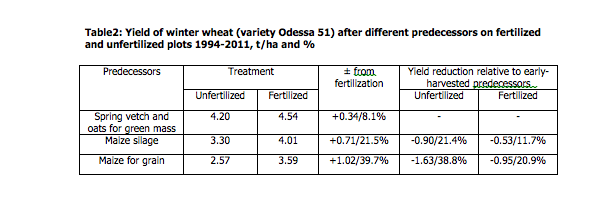



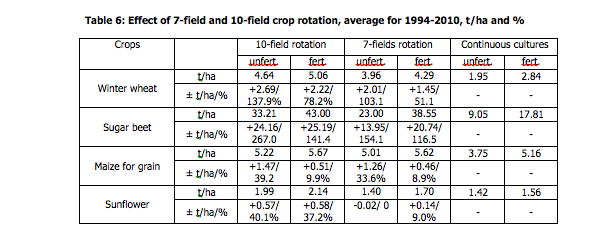

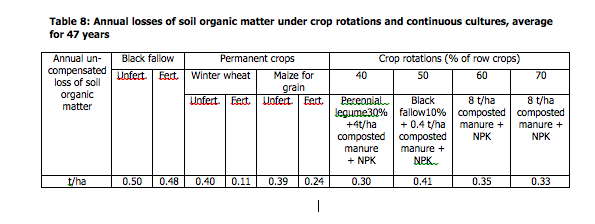
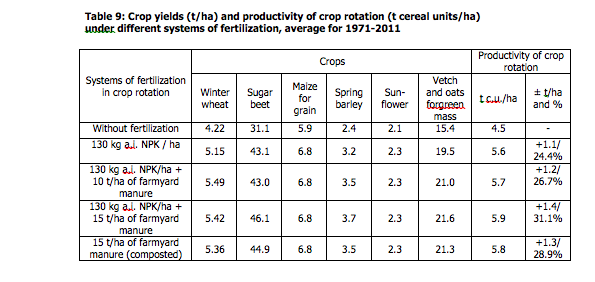
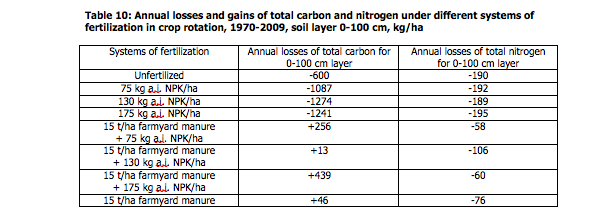
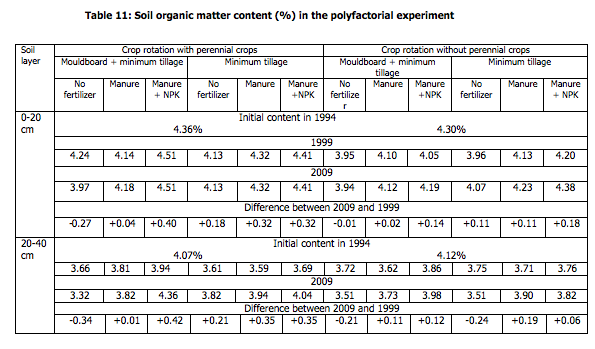
(1) The effect of crop rotation is the difference between yields in crop rotation and in continuous cultivation of the same crop, both on fertilized and unfertilized plots.
(2) A comparable picture emerges from systematic studies of the influence of agricultural management on soil organic carbon in Canada. Carbon storage increased in their black earths under no-till systems; under reduced summer fallow, and in crop rotations that include grasses and perennial legumes, ploughing-in green manures, and applying fertilizers. The 20-year average soil-organic-carbon-gain factors derived from field experiments and modelling were: 0.1-0.14 tonne/ha/year for no-till, 0.3 tonne/ha/year for decreasing bare fallow, and 0.55-0.56 tonneC/ha/yr for introduction of perennials into the rotation.
Fotocredits: conbon33, China
Dit artikel afdrukken
The green revolution depended on cheap fuel and derivative fertilizer and pesticides applied to new, responsive crop varieties, and on the extension of irrigation. Fuel and fertilizer are no longer cheap; water resources are over-committed and rising demand from cities means less water will be available for irrigation. Crop yields have levelled off – in several areas they are declining. But burgeoning demand means that, by 2050, food production will need to be 70 per cent greater than now – and double in developing countries. This greater production will have to come from the same land and water resources or, if present trends continue, significantly less. On top of historical land degradation going back 10 000 years in long-settled regions, the last quarter century has witnessed degradation of one quarter of the land surface - one third of forests, one quarter of the arable; and tracts of the best farmland are being lost every year to cities and connecting infrastructure.
Since the 1960s, the structure of agriculture and rural communities has changed profoundly. Crop rotations were simplified: perennial legumes were replaced by cheap nitrogen from mineral fertilizers, and wide spectrum fungicides and herbicides enabled second and third consecutive cereal crops to be grown before introducing a break crop. Mixed farming declined with a separation of arable and animal husbandry. Mechanization enabled more production with fewer and fewer people. The downward pressure on farm-gate prices and the increasing capital costs of modern equipment brought about a steady loss of small and medium-sized family farms; successful commercial farms were greatly enlarged. Knowledge of the land, skills, and locally adapted crop and animal breeds were extinguished.
The resulting environmental and social problems have become more and more acute. In the first place, neglect of crop rotation and of the importance of soil fertility have brought about stagnation or, even, decline of yields for most crops. Soil health and quality depend on soil biodiversity – microorganisms and microscopic animals as well as the familiar earthworm that maintain soil permeability, resilience against erosion, recycle wastes into plant nutrients and maintain a balance with pathogens. But no modern farming system is maintaining the soil organic matter that fuels soil biodiversity. A significant deterioration of soil quality has been compensated by increased inputs of mineral fertilizer - from both the energy and economic points of view, food production is becoming more expensive.
Ten key points from long-term field experiments
The economic losses of abandoning crop rotation were underestimated during the era of cheap mineral fertilizers, quite apart from the negative effects on the environment and human health.
Data from the long-term field experiments on Typical chernozem soil at Selectia Research Institute of Field Crops, at Balti in Moldova, demonstrate real possibilities for improving soil health, cutting expenses and maintaining the highest crop yields by respecting crop rotation.
1. Comparing the performance of continuous monoculture with crop rotations, mineral and organic fertilizers increase the yields of continuous monocultures much more than the same fertilizer applied to crop rotations (Tables 1, 3, 4 and 5). This is because the root systems of continuous cultures have only a weak capacity of to access water and nutrients, compared with those of crops grown in rotation. As a corollary, the effect of crop rotation is greater on unfertilized than on fertilized plots.
2. Fertilizer reduces the effect of rotation but doesn’t replace it. Even on fertilized plots, the effect of crop rotation(1) is significantly greater than the influence of fertilizers for all crops except maize.
3. In the case of winter wheat sown after a late-harvested predecessor, the positive influence of fertilization is equal to yield loss incurred by late sowing as opposed to sowing early (Table 2). It is cheaper to respect crop rotation than to compensate for its absence with extra fertilizer.
4. The greater the diversity of crops in a crop rotation, the higher yields of individual crops and the greater the effect of crop rotation (Table 6).
5. On unfertilized plots, the yield is created entirely from soil fertility; on fertilized plots, the yield is generated from both from soil fertility and from fertilizers. In crop rotations, the contribution of soil fertility to yield formation on fertilized plots is very high for winter wheat, sunflower and maize (92-93%) but lower for sugar beet (69%). The contribution of soil fertility to yield formation is significantly lower in continuous cultures: 54-56% for winter wheat and maize; 91% for sunflower (which hardly reacts either to rotation and fertilization); and only 3% for sugar beet (Table 7).
So, fertilizer is more effective in continuous cultures than in crop rotation. The corollary is that, by respecting crop rotation, it is possible to cut the dependence upon mineral fertilizers. Returning perennial legumes to crop rotations replaces the nitrogen from mineral fertilizers by nitrogen from biological fixation. There are further benefits from the exploitation of deep-seated water and nutrients, and from the enrichment of the soil with organic matter.
6. Crop rotations arrest the infestation of disease, pests and weeds. This means that it is possible to reduce the application of pesticides which have a negative influence on biodiversity and water quality.
7. Crop rotations are more-efficient water harvesters than continuous cultures; they drought-proof the farming system.
8. Soil organic matter is an integral index of soil fertility. Crop rotation alone doesn’t compensate for the annual losses of soil organic matter, even with 30 per cent of perennial legumes and 4 tonne/ha of farmyard manure (Tables 8, 11). More farmyard manure is needed. Maintenance and restoration of soil organic matter, efficient recycling of nutrients and reduction of the dependence on off-farm inputs requires integration of crop and animal husbandry. Importantly, animal husbandry provides a financial return on legumes and grass, compensating for what would otherwise be a loss of income from the cash crops forsaken.
9. Mineral and organic fertilizers influence the yield of crops and soil fertility in different ways. Both increase the yield of crops and the productivity of the whole crop rotation (Table 9). Organic fertilizers are not inferior to mineral fertilizer in respect of their benefit to crop yields and the productivity of the whole crop rotation but reliance on mineral fertilizers reduces the stocks of soil organic carbon throughout the soil profile - to a depth of 1 metre or more. By contrast, organic fertilizers like farmyard manure increase the stocks of soil carbon, especially in the deeper soil layers. All systems of fertilization deplete stocks of total nitrogen, but the negative influence of mineral fertilizers is significantly higher than that of farmyard manure or a mixture of both.
10. Polyfactorial trials involving 7-field rotations with and without perennial legumes, with and without ploughing, with various combinations of farmyard manure and NPK fertilizer and without fertilizer (Table 11) demonstrate that farming practices drive the accumulation or decline of soil organic matter. Soil organic matter status can be raised by crop rotations that include perennial legumes and enough farmyard manure, especially under minimum tillage. Crop yields have responded positively to this increase on soil organic matter. Growing perennial legumes is significant both in increasing soil organic matter and in reducing dependence on artificial fertilizers(2).











(1) The effect of crop rotation is the difference between yields in crop rotation and in continuous cultivation of the same crop, both on fertilized and unfertilized plots.
(2) A comparable picture emerges from systematic studies of the influence of agricultural management on soil organic carbon in Canada. Carbon storage increased in their black earths under no-till systems; under reduced summer fallow, and in crop rotations that include grasses and perennial legumes, ploughing-in green manures, and applying fertilizers. The 20-year average soil-organic-carbon-gain factors derived from field experiments and modelling were: 0.1-0.14 tonne/ha/year for no-till, 0.3 tonne/ha/year for decreasing bare fallow, and 0.55-0.56 tonneC/ha/yr for introduction of perennials into the rotation.
Fotocredits: conbon33, China
Nog 3
Je hebt 0 van de 3 kado-artikelen gelezen.
Op 3 augustus krijg je nieuwe kado-artikelen.
Op 3 augustus krijg je nieuwe kado-artikelen.
Als betalend lid lees je zoveel artikelen als je wilt, én je steunt Foodlog









_002_480_289_84_s_c1.jpg)



Kweken dat vlees? Ben je nu helemaal gek geworden? Hoe ver ben jij nu al van de natuur afgedwaald?
Piet: vergeet ook niet de rijstteelt in Afrika voor en door China - zoals in Ethiopië.
Die rijst is niet bedoeld voor de Afrikanen zelf - die worden juist uit hun bestaan gezet.
Zoals Hendrik opmerkt is het maximum aan kunstmestbelasting daar reeds bereikt - en zal ook in die nieuwe landen een probleem gaan worden. Dus zal het anders moeten. Een andere gewaskeuze - zoals voor Amarant - zou al een wereld van verschil maken.
Naast wissel-akkerbouw moeten ook de graslanden niet vergeten worden: zie dit uitgebreide artikel over het allerbeste grasland voor het meest gezonde vee en de best mogelijke N - huishouding.
Ter aanvulling bij #1
- rijst wordt uitgefaseerd in China vanwege gebrek aan water in het noorden van China. Het water wordt met kanalen omgeleid. De rijstteelt gaat naar Myanmar, Cambodja, etc. Vandaar de interesse van de Chinese overheid in deze landen.
- Er is geen landbouwonderwijs in China op praktijkniveau. Er is weinig kennis bij de boeren, dus die gebruiken 'goedkope' inputs: oude rassen, goedkope ongereinigde kunstmest en generieke bestrijdingsmiddelen. Dit leidt tot lage productie en vervuiling.
- voedsel is politiek. De prijzen worden laag gehouden.
Dit is een notendop de problematiek van de Chinese landbouw:
- water
- kennis
- lage prijzen
Juist in China is het rendement van kunstmest (N bijvoorbeeld) vaak bijzonder slecht. Merkwaardig is dan juist dit plaatje uit China bij deze tekst. Intensivering, dus meer N etc. is de enige mogelijkheid voor China om haar groeiende bevolking van voedsel te blijven voorzien. Op de markt is er voor China te weinig verkrijgbaar voor zulke aantallen. China is momenteel al 's werelds grootste gebruiker van N, met een verbruik van haast vier keer meer dan in de VS, op de rijstvelden meer dan 400 kg N/ha. Planten kunnen dat niet allemaal behappen en daarom ligt de efficiency beneden 50%, voor rijst zelfs beneden 30%. Kijk maar eens in de fotoreportage wat dat voor gevolgen heeft wanneer zoveel N uitlekt naar het oppervlakte water. (groene soep) Hiermee verpesten ze hun rivieren en kustwateren.